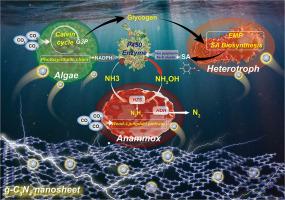Photocatalysis-fueled algae-bacteria mutualism enables P450 enzyme-induced nitrite-free anammox for sustainable nitrogen removal
IF 12.4
1区 环境科学与生态学
Q1 ENGINEERING, ENVIRONMENTAL
引用次数: 0
Abstract
Anaerobic ammonium oxidation (anammox) relies on scarce nitrite in wastewater to produce hydroxylamine, a key substrate for anammox nitrogen removal, severely limiting its sustainable implementation. This study pioneers a photocatalysis-driven algae-bacteria mutualistic platform for activating a microalgal P450 enzyme-induced nitrite-independent anammox pathway. This platform integrates two functional blocks: photocatalysis-induced P450 activation circuit, and P450-mediated algal–anammox nitrogen removal module. First, photocatalysis rewired microalgal carbon flux to foster cooperation with heterotrophic ACID1, enabling ACID1-derived salicylic acid to feedback-regulate the biosynthesis of key P450 cofactors—iron–porphyrin and Fe–S clusters. Meanwhile, photogenerated electrons boosted NADPH (FC=2.33), directly fueling P450 activation. In this way, microalgal P450 enzymes were robustly activated to unprecedented levels, emerging as the most abundant protein family in CYAN1. Second, P450-catalyzed monooxygenation of ammonia to hydroxylamine bypassed nitrite, enabling a previously inaccessible microalgae–anammox synergistic nitrogen removal mode, achieving an ultra-high nitrogen removal efficiency of 99% without nitrite and with negligible greenhouse gas emissions. This strategy offers new insights into algal-bacterial cooperation and opens avenues for multi-channel solar-to-biochemical energy conversion in photocatalyst-microbe biohybrids for sustainable wastewater treatment.

光催化驱动的藻类-细菌共生使P450酶诱导的无亚硝酸盐厌氧氨氧化能够持续去除氮
厌氧氨氧化(anammox)依赖于废水中稀缺的亚硝酸盐产生羟胺,而羟胺是厌氧氨氧化脱氮的关键底物,严重限制了其可持续实施。本研究开创了一个光催化驱动的藻类-细菌共生平台,用于激活微藻P450酶诱导的不依赖亚硝酸盐的厌氧氨氧化途径。该平台集成了两个功能模块:光催化诱导的P450激活电路和P450介导的藻类厌氧氨氧化脱氮模块。首先,光催化重新连接微藻碳通量,促进与异养ACID1的合作,使ACID1衍生的水杨酸能够反馈调节关键P450辅因子-铁卟啉和Fe-S簇的生物合成。同时,光电子提高了NADPH (FC=2.33),直接促进了P450的活化。通过这种方式,微藻P450酶被强烈激活到前所未有的水平,成为CYAN1中最丰富的蛋白家族。其次,p450催化的氨单氧氧化制羟胺绕过亚硝酸盐,实现了以前难以实现的微藻-厌氧氨氧化协同脱氮模式,实现了99%的超高脱氮效率,无需亚硝酸盐,温室气体排放量可忽略不计。该策略为藻类-细菌合作提供了新的见解,并为光催化剂-微生物生物杂交体的多渠道太阳能-生化能量转换开辟了道路,以实现可持续的废水处理。
本文章由计算机程序翻译,如有差异,请以英文原文为准。
求助全文
约1分钟内获得全文
求助全文
来源期刊

Water Research
环境科学-工程:环境
CiteScore
20.80
自引率
9.40%
发文量
1307
审稿时长
38 days
期刊介绍:
Water Research, along with its open access companion journal Water Research X, serves as a platform for publishing original research papers covering various aspects of the science and technology related to the anthropogenic water cycle, water quality, and its management worldwide. The audience targeted by the journal comprises biologists, chemical engineers, chemists, civil engineers, environmental engineers, limnologists, and microbiologists. The scope of the journal include:
•Treatment processes for water and wastewaters (municipal, agricultural, industrial, and on-site treatment), including resource recovery and residuals management;
•Urban hydrology including sewer systems, stormwater management, and green infrastructure;
•Drinking water treatment and distribution;
•Potable and non-potable water reuse;
•Sanitation, public health, and risk assessment;
•Anaerobic digestion, solid and hazardous waste management, including source characterization and the effects and control of leachates and gaseous emissions;
•Contaminants (chemical, microbial, anthropogenic particles such as nanoparticles or microplastics) and related water quality sensing, monitoring, fate, and assessment;
•Anthropogenic impacts on inland, tidal, coastal and urban waters, focusing on surface and ground waters, and point and non-point sources of pollution;
•Environmental restoration, linked to surface water, groundwater and groundwater remediation;
•Analysis of the interfaces between sediments and water, and between water and atmosphere, focusing specifically on anthropogenic impacts;
•Mathematical modelling, systems analysis, machine learning, and beneficial use of big data related to the anthropogenic water cycle;
•Socio-economic, policy, and regulations studies.
 求助内容:
求助内容: 应助结果提醒方式:
应助结果提醒方式:


